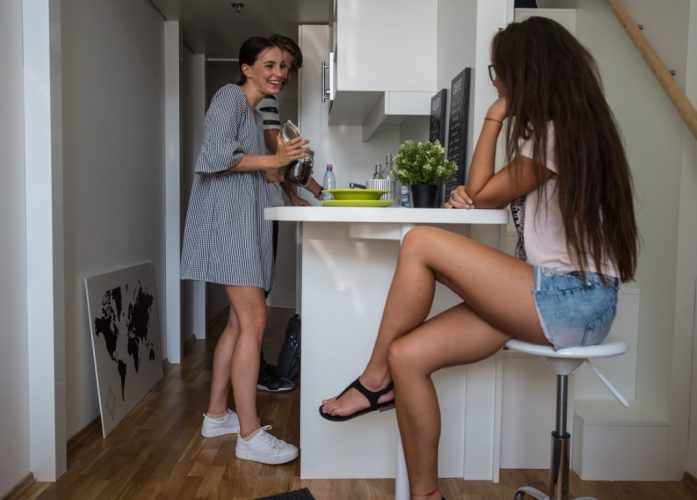The Coronavirus has certainly presented a challenge to us all. In order to contain the spread, we have been asked to limit our social contacts and spend some time within our own four walls. However, how can these guidelines be translated for those living in a community apartment? Here are some tips on how to deal with the situation.
Traffic restrictions, the closure of shops and an almost complete shutdown of public life. These new developments brought along with the Coronavirus have been shocking, to say the least. Nevertheless, we can appreciate the importance of staying home to ensure the safety and well-being of others. However, for individuals living together in a community apartment, being in quarantine can potentially become a point of conflict. We’ve gathered some practical tips on how you can navigate this territory.
Before we begin, it is vital to state that the key to everything stated below is: communication. Grab your roommates and talk about some of the key topics we’ve provided and agree that you will all need to prepare to compromise, for everyone’s benefit.

First, it is best to sit down with your roommates and begin with an ‘inventory’ of sorts. Did any of you recently spend time in an ‘area of risk’? You can find a continuously updated list and definition of such areas by the German, Robert Koch Institute, for instance. If the answer is ‘yes’, then the shared apartment needs to enter a strict quarantine as according to any current, official regulations. The same applies if there has been any contact with someone who is proven to be infected.
Not sure what else to consider? The decision tree featured on ZEIT ONLINE (German Newspaper), may provide some help. If all your roommates, yourself included, do not feel they are currently a risk then you may continue onto the next point.
Certain groups of individuals are much more at risk of catching and being more severely affected by the Coronavirus. For instance, we know that the elderly, particularly those suffering from an illness or disease are high-risk. The same goes for young adults who suffer from a weaker immune system, an illness or disease. The Robert Koch Institute, as mentioned previously, also provides a list of these groups. If you have identified a member of your community apartment to be more at risk, pay attention to the following guidelines to ensure the safety of the individual.

And the hashtag of the hour states ‘#stayhome’, and rightly so. Though some regulations, in regards to the handling of the outbreak differ from region to region, the general consensus remains: stay home. Your compliance means that you protect yourself and everybody else. There has never been an easier way to contribute for the better good, than by sitting on your couch, in your jogging pants.
Try to keep yourself informed about any developments so the experts can tell us what we can do. Yes, we would all love a taste of that spring sunshine but if we all remain consequent, we may still have our summer. Many festival organizers have started using the #savethesummer for good reason.
Even in a community apartment, this is possible. This doesn’t mean you have to lock yourself up, alone, in your room all day. Instead, try to space yourselves out and use community spaces such as the kitchen, one at a time. If not, ensure that everyone is paying extra attention to hygiene standards and that items and surfaces which can get dirty, are cleaned and disinfected regularly.
5.Minimize risk from the outside world
Your actions outside the community apartment are just as vital as within it. It’s of very little use when you’re being cautious inside but inviting friends and family members to come in and out of the apartment, as if we weren’t in the middle of a health crisis. Limit your contact towards the outside or at best, avoid it as best as possible. That means avoiding going outside unless absolutely essential.
The advantage of living in a community apartment, is that you can help each other to do so. For example, before all members of the household go shopping three times a week each, have someone volunteer to go for everyone. At this time, also remember to be mindful of others even at the supermarket and avoid ‘panic buying’. Supplies are a plenty so there is no need for empty shelves and unused food to be thrown in the trash.
Your actions outside the community apartment are just as vital as within it. It’s of very little use when you’re being cautious inside but inviting friends and family members to come in and out of the apartment, as if we weren’t in the middle of a health crisis. Limit your contact towards the outside or at best, avoid it as best as possible. That means avoiding going outside unless absolutely essential.
The advantage of living in a community apartment, is that you can help each other to do so. For example, before all members of the household go shopping three times a week each, have someone volunteer to go for everyone. At this time, also remember to be mindful of others even at the supermarket and avoid ‘panic buying’. Supplies are a plenty so there is no need for empty shelves and unused food to be thrown in the trash.
Naturally, your time at home could be a little tough and exhausting. A space can feel very limiting when spring is in full bloom outside. Respect your roommates, stick to the plan and save yourselves the drama.
Don’t let the boredom get to you. Though you may find that difficult once you have worked through your list of to-do’s for university and co., we have also published a list of activities, you can do to avoid boredom. To top it off, we also have published a list of English-speaking podcasts you can try out.
